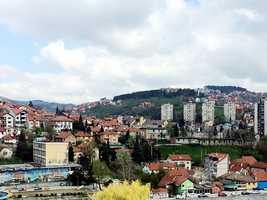
Užice is a city and the administrative center of the Zlatibor District in western Serbia. The town of Užice lies close to where a river Djetinja exits its canyon into a valley constricted by steep hills and rocks. It's high rises and rows of houses perched on the hills look much more impressive from afar than when approached, yet they do create a very specific feel. The undisputed centre of the town is the board Trg partizana. It was laid out after the WWII and named after the communist guerilla fighters who held the town in 1941. Another statement of the colossal Hotel "Zlatibor" whose 15-stories of raw concrete loom over the square. Jokanović House, today housing the Ethnographic Collection, has been chosen as a fine example of a town house from the 19th c done in oriental Balkan style, quite different from the local architecture. Church of St Mark is the oldest church in town, it was built in 1828 in post and petrail construction, with a steep roof characteristic for western Serbia. The National Museum lies at the foot of the wooded hill in a stout building where the Headquarters of the partisan "National Liberation Movement of Yugoslavia" was together with the Central Committee of Communist Party of Yugoslavia, as well as a partisan weapon and ammunition factory which was in the cellar. In the museum's yard, you will find a huge statue of Tito. Potpeć Cave a remarkable monument of nature, is in a village Potpeće, 14 km east from Užice.
To receive our best monthly deals
JOIN THE NEWSLETTER
